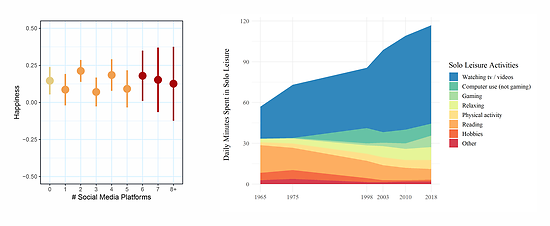Arbeitsbereich
Bevölkerungsdynamik und Nachhaltiges Wohlbefinden
Auf einen Blick
Projekte
Publikationen
Team
Projekt
Technologiegebrauch und seine Effekte auf Zeitnutzungsmuster, soziale Beziehungen und Wohlbefinden
Robert Gordon Rinderknecht, Sophie Lohmann, Daniela Veronica Negraia, Emilio Zagheni
Ausführliche Beschreibung
Technology use, including the use of digital media and social networking sites, is playing an important role in the everyday life of many people. Despite its prevalence, it is not yet clear how this affects our lives. This project examines the implications of technology and digital media use on various aspects of our lives. One subproject focuses on the ways in which the digitalization of life has changed the way we use our time, the type of activities we engage in, the places where we spend our time, and the people with whom we do so. A second subproject examines whether this new way of life has any effects on our health and on how satisfied we are with our lives and relationships.
The Internet, smartphones, and social networking sites have resulted in one of the largest social discontinuities in recent history. We still do not understand the consequences of the digitalization of life for people’s time use and well-being. As part of the first subproject mentioned above, we examined how digitalization affects the way individuals spend their time. Our analyses based on the American Heritage Time Use Study (1965 to 2018) have shown that Americans in 2018 spent about twice as much time in solitary leisure compared to Americans in 1965 (Rinderknecht et al. 2023). However, this change differed across the groups we studied. Whereas married respondents reported virtually no change in solitary leisure, unmarried respondents and especially unmarried respondents living alone reported a significant growth in such isolation. But demographic changes and changes in the total amount of time spent in leisure only explain around half of the growth in solitary leisure between 1965 and 2018. We discussed in this article (Rinderknecht et al. 2023) that technology and other social changes potentially explain the other half and expanded on this discussion in a book chapter exploring recent research in digital and computational demography (Kashyap et al. 2023).
The increasing presence of social media in our lives has brought rising concerns that using social media might make us unhappier. The scientific evidence has often been contradictory, and most work examined the use of social media as a single, unitary construct. To provide a more detailed answer, we analyzed the effect of multi-platform use on well-being. For example, are people who use Facebook, Twitter, Pinterest, and Snapchat unhappier than those who use only Facebook? And are these in turn unhappier than those who are not on social media at all? We analyzed data from the General Social Survey, a representative sample of US adults, and applied propensity-score adjustment techniques to partially correct for self-selection effects (Lohmann and Zagheni 2020). Overall, we have found no consistent effects on well-being. When we did see negative effects of multi-platform use, for example symptoms of depression, these were limited to middle-aged and older people. And they did not apply to young adults. These findings contribute to the debate on the health-related effects of social media and provide evidence that even multi-platform social media users did not report lower well-being than did less intensive users.
Die Zeit, die wir in unserer Freizeit allein mit der Technik verbringen, hat zugenommen, aber es gibt keinen Zusammenhang zwischen der Anzahl der von uns genutzten Social-Media-Plattformen und unserer Zufriedenheit

(A) Mittelwerte und 95 %-Konfidenzintervalle des selbst eingeschätzten Glücks (1 = sehr glücklich, 0 = ziemlich glücklich, -1 = nicht so glücklich), aufgeschlüsselt danach, wie viele Social-Media-Plattformen die Befragten nutzten (Daten: General Social Survey, 2016). (B) Die Abbildung zeigt die durchschnittlichen täglichen Minuten, die zwischen 1965 und 2018 in einsamer Freizeit verbracht wurden, aufgeschlüsselt nach Art der Freizeitaktivität (Daten: American Heritage Time Use Study (AHTUS)). © MPIDR
Publikationen
Kashyap, R.; Rinderknecht, R. G.; Akbaritabar, A.; Alburez-Gutierrez, D.; Gil-Clavel, B. S.; Grow, A.; Kim, J.; Leasure, D. R.; Lohmann, S.; Negraia, D. V.; Perrotta, D.; Rampazzo, F.; Tsai, C.-J.; Verhagen, M. D.; Zagheni, E.; Zhao, X.:
In: Research handbook on digital sociology, 48–86. Cheltenham: Edward Elgar Publishing. (2023)
Rinderknecht, R. G.; Negraia, D. V.; Lohmann, S.; Zagheni, E.:
MPIDR Working Paper WP-2023-025. (2023)

Lohmann, S.; Zagheni, E.:
MPIDR Working Paper WP-2020-023. (2020)
